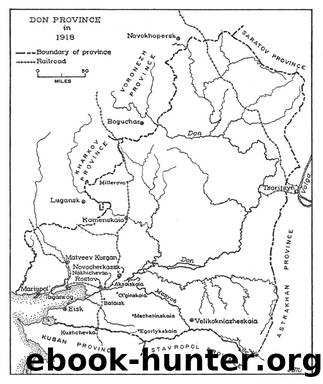Red Attack, White Resistance by Peter Kenez

Author:Peter Kenez [Kenez, Peter]
Language: eng
Format: epub
Tags: History, Russia & the Former Soviet Union
ISBN: 9780974493442
Google: lpk3AgAACAAJ
Publisher: New Academia Publishing
Published: 2004-01-15T01:42:11+00:00
BATTLES FOR TSARITSYN
The period from May to the end of July 1918 was one of uninterrupted successes for the Don army. As a result of their traditional military organization the Cossacks were able to mobilize quickly and by the end of July they had about forty thousand soldiers, which equalled the number of Red troops facing them.23 The Cossacks, fighting for the liberation of their voisko, were excellent soldiers and in June and July they advanced successfully on all fronts. The crucial front followed the Likhaia-Tsaritsyn railroad line. The Cossacks were able to cut it at the time when the Volunteer Army occupied Torgovaia and Velikokniazheskaia on the Tsaritsyn Tikhoretskaia line, and consequently all the major railroad links between the Red troops at Tsaritsyn and the other Soviet armies were severed.24
The Bolshevik position was very difficult. The defeats on the Don coincided with the emergence of a new anti-Bolshevik front in the east created by the uprising of the Czechs and the offensive of the Ural Cossacks under Ataman Dutov. Thus in the second half of 1918 the Bolsheviks had to fight on two main fronts which they considered equally important, and to which they sent troops of equal strength.25
In the middle of July, S. K. Minin, J. V. Stalin, and K. E. Voroshilov formed the Soviet of the Northern Caucasus Military District, whose main task was to organize the defense of Tsaritsyn. It was also responsible for all Red armies in the Northern Caucasus, including those which faced the Volunteer Army.26 Voroshilov, as Commander-in-Chief of the Southern front, gradually succeeded in building an army from the remnants of the Don and Ukrainian Soviet armies, and from the workers of Tsaritsyn.27 By the end of July the Tsaritsyn front was stabilized.
In the second half of 1918, fortune changed several times on the crucial Tsaritsyn front. By the end of August the Bolsheviks felt strong enough to start for the first time a large scale counter-attack along the three major railroad lines. Initially the offensive was suecessful; but Krasnov withdrew some of his troops from the direction of Voronezh and used all his reserves, and by mid-September, Voroshilov had been stopped and the front pushed back to where it had been a month before. In early October Tsaritsyn was surrounded. Once again the Bolsheviks carried out a large scale reorganization. The ex-tsarist General Sytin was named commander on the Southern front, which was divided into six armies. Four of these fought the Cossacks of the Don: the Seventh and Eighth in the district of Voronezh, the Ninth in the district of Tambov, and the Tenth, under the personal command of Voroshilov, in Tsaritsyn.28
It was not the reorganization, however, but D. Zhlobaâs Steel Division which saved Tsaritsyn. The Division had belonged to Sorokinâs Eleventh Army. Zhloba had left the North Caucasian front against the orders of his superior, and his departure caused great confusion there, enabling Denikin to seize Armavir. The fifteen thousand men made forced marches at night, covering the distance
Download
This site does not store any files on its server. We only index and link to content provided by other sites. Please contact the content providers to delete copyright contents if any and email us, we'll remove relevant links or contents immediately.
| Africa | Americas |
| Arctic & Antarctica | Asia |
| Australia & Oceania | Europe |
| Middle East | Russia |
| United States | World |
| Ancient Civilizations | Military |
| Historical Study & Educational Resources |
Red Famine: Stalin's War on Ukraine by Anne Applebaum(2466)
Chernobyl by Serhii Plokhy(2128)
Midnight in Chernobyl by Adam Higginbotham(2080)
The House of Government by Slezkine Yuri(1846)
Midnight in Chernobyl: The Untold Story of the World's Greatest Nuclear Disaster by Adam Higginbotham(1776)
Red Shambhala by Andrei Znamenski(1749)
The Gulag Archipelago (Vintage Classics) by Aleksandr Solzhenitsyn(1725)
From Cold War to Hot Peace by Michael McFaul(1712)
All the Kremlin's Men by Mikhail Zygar(1698)
Putin's Labyrinth(1656)
Red Notice by Bill Browder(1592)
The Future Is History by Masha Gessen(1591)
From Russia with Lunch by David Smiedt(1551)
A People's Tragedy by Orlando Figes(1544)
The Romanovs by Simon Sebag Montefiore(1487)
How to Tame a Fox (and Build a Dog): Visionary Scientists and a Siberian Tale of Jump-Started Evolution by Lee Alan Dugatkin & Lyudmila Trut(1469)
Putin's Labyrinth: Spies, Murder, and the Dark Heart of the New Russia(1455)
The Lost Spy by Andrew Meier(1398)
Art and Revolution by John Berger(1386)
